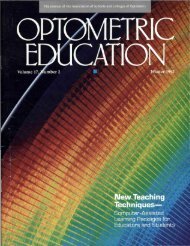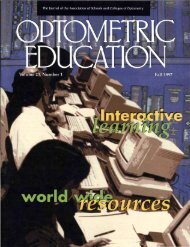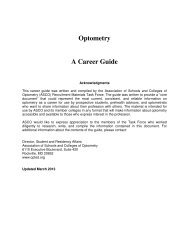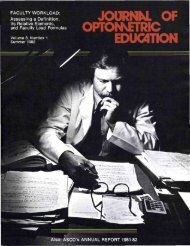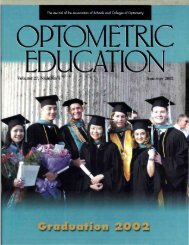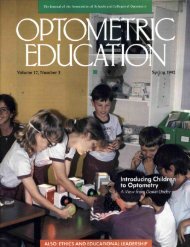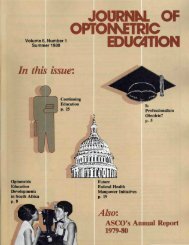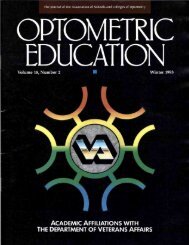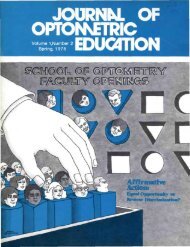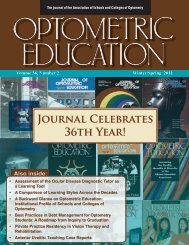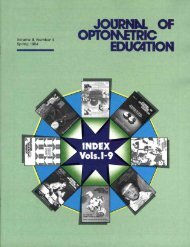Summer 2012, Volume 37, Number 3 - Association of Schools and ...
Summer 2012, Volume 37, Number 3 - Association of Schools and ...
Summer 2012, Volume 37, Number 3 - Association of Schools and ...
You also want an ePaper? Increase the reach of your titles
YUMPU automatically turns print PDFs into web optimized ePapers that Google loves.
vices to the people in the community.<br />
The patient had received medical care<br />
at the clinic during the past 4 years, although<br />
this was the first time she was<br />
examined at the eye clinic. The patient<br />
could not recall the date or provider <strong>of</strong><br />
her last eye exam. Her main complaint<br />
was eye fatigue. Her eyes felt “heavy <strong>and</strong><br />
tired.” The eye fatigue would occur after<br />
the patient had been working all day<br />
on the computer, <strong>and</strong> it had started 3-4<br />
months ago. In the past, the eye fatigue<br />
had resolved on its own. The patient<br />
did not wear any spectacle correction<br />
<strong>and</strong> reported good distance <strong>and</strong> near<br />
vision. The patient felt the eye fatigue<br />
was related to excessive computer use<br />
<strong>and</strong> an increase in job responsibilities,<br />
which occurred 3-4 months ago. The<br />
patient, an administrative assistant at a<br />
local university, reported spending approximately<br />
6-8 hours per workday on<br />
the computer. She said the symptoms<br />
did improve on the weekend with less<br />
computer use, <strong>and</strong> she did not report<br />
any other ocular symptoms.<br />
Past ocular history <strong>of</strong> the patient <strong>and</strong> her<br />
family were unremarkable. Her medical<br />
history was positive for hypertension<br />
for the past 14 years, obesity, asthma<br />
<strong>and</strong> depression. The patient reported<br />
longst<strong>and</strong>ing (ongoing at least 3-5<br />
years), occasional headaches relieved by<br />
Motrin. The headaches were not related<br />
to her complaint <strong>of</strong> eye fatigue <strong>and</strong> occurred<br />
r<strong>and</strong>omly. There had been no<br />
recent changes in her headaches. Her<br />
primary care physician (PCP) had evaluated<br />
the headache complaint <strong>and</strong> felt<br />
tension headaches were the most likely<br />
cause. The patient’s current medications<br />
were: hydrochlorothiazide 25 mg per<br />
day, linsinopril 40 mg per day, atenolol<br />
50 mg per day, <strong>and</strong> Flovent twice daily.<br />
The patient was allergic to Augmentin<br />
<strong>and</strong> morphine. The patient reported<br />
fair compliance with hypertension<br />
medications. She admitted to not using<br />
all three <strong>of</strong> the medications prescribed<br />
for hypertension on a consistent basis.<br />
The patient’s medical records were accessed<br />
by an electronic medical records<br />
system <strong>and</strong> indicated blood pressure<br />
readings <strong>of</strong> 150/103 mmHg in 2011<br />
<strong>and</strong> 156/103 mmHg in 2010. At her<br />
annual physical exam in 2011, the patient’s<br />
height was recorded as 61 inches<br />
<strong>and</strong> her weight was recorded as 260 lbs.<br />
The patient was alert <strong>and</strong> oriented <strong>and</strong><br />
reported no current use <strong>of</strong> recreational<br />
drugs or alcohol. The patient said she<br />
smoked half a pack <strong>of</strong> cigarettes per<br />
day.<br />
The initial differential diagnosis based<br />
on symptoms <strong>and</strong> case history consisted<br />
<strong>of</strong>: dry eye syndrome (primary<br />
or secondary), uncorrected refractive<br />
error, specifically hyperopia, binocular/<br />
accommodative anomalies, or asthenopia<br />
related to excessive computer use.<br />
The patient was also considered at risk<br />
for hypertensive retinopathy secondary<br />
to her history <strong>of</strong> poor compliance<br />
Distance <strong>and</strong> near visual<br />
acuity, sc<br />
Pupils<br />
Motility-extra ocular<br />
muscles<br />
OD<br />
<strong>and</strong> poor control. The findings for the<br />
comprehensive eye exam are listed in<br />
Table 1.<br />
The initial impression was bilateral disc<br />
edema. Hypertensive emergency, also<br />
known as malignant hypertension, vs.<br />
other causes for the disc edema were<br />
considered. Moderate hypertensive<br />
retinopathy with other causes for the<br />
disc edema was also a possibility. Although<br />
there are many possible differential<br />
diagnoses for disc edema, IIH,<br />
space-occupying lesion or infection<br />
were the most significant at this time.<br />
OS<br />
20/20 20/20<br />
Pupils equal, round <strong>and</strong> reactive to light (PERRL)<br />
Negative afferent pupillary defect (APD)<br />
Smooth, accurate, full <strong>and</strong> extensive<br />
Color vision (Ishihara) 11/11 11/11<br />
Cover test<br />
Ortho dist <strong>and</strong> 4 prism diopters exophoria at near<br />
Finger counting fields Full Full<br />
Near-point convergence<br />
To the nose<br />
Retinoscopy +0.50= -0.25 x 90 +0.25<br />
Subjective refraction +0.75= -0.25 x 90 20/20 Plano 20/20<br />
Slit lamp<br />
Capped meibomian gl<strong>and</strong>s lower lid<br />
Otherwise all structures unremarkable<br />
TBUT 5 seconds 5 seconds<br />
Intraocular pressures<br />
(GAT) @ 6 p.m.<br />
Dilated @7:30 p.m.<br />
Patient gave consent for<br />
dilation <strong>and</strong> indicated she<br />
understood benefits <strong>and</strong><br />
potential side effects<br />
Fundus exam with 90D<br />
lens <strong>and</strong> binocular indirect<br />
ophthalmoscopy<br />
Blood pressure with largeperson<br />
cuff, patient sitting<br />
Table 1<br />
Comprehensive Initial Eye Exam: May 3, 2011<br />
15 mmHg 10 mmHg<br />
1 drop 2.5% phenylephrine (punctal<br />
occlusion)<br />
2 drops 1.0 % tropicamide<br />
Disc: elevated, blurred margins, 360<br />
degrees, hyperemic in color<br />
Blood vessels: A/V crossing changes<br />
with engorgement <strong>of</strong> vessels<br />
Background: multiple flame-shaped<br />
hemorrhages<br />
Cup/disc estimate: H/V 20/20%<br />
Macula: clear<br />
Periphery: no holes, tears or detachments<br />
Right arm<br />
180/115 mmHg<br />
Capped meibomian gl<strong>and</strong>s lower lid<br />
Otherwise all structures unremarkable<br />
1 drop 2.5% phenylephrine (punctal<br />
occlusion)<br />
2 drops 1.0 % tropicamide<br />
Disc: elevated, blurred margins, 360<br />
degrees, hyperemic in color<br />
Blood vessels: A/V crossing changes<br />
with engorgement <strong>of</strong> vessels<br />
Background: multiple flame-shaped<br />
hemorrhages<br />
Cup/disc estimate: H/V 20/20%<br />
Macula: clear<br />
Periphery: no holes, tears or detachments<br />
Left arm<br />
160/120 mmHg<br />
Fundus photos Figure 1 OD Figure 2 OS<br />
Optometric Education 116 <strong>Volume</strong> <strong>37</strong>, <strong>Number</strong> 3 / <strong>Summer</strong> <strong>2012</strong>



